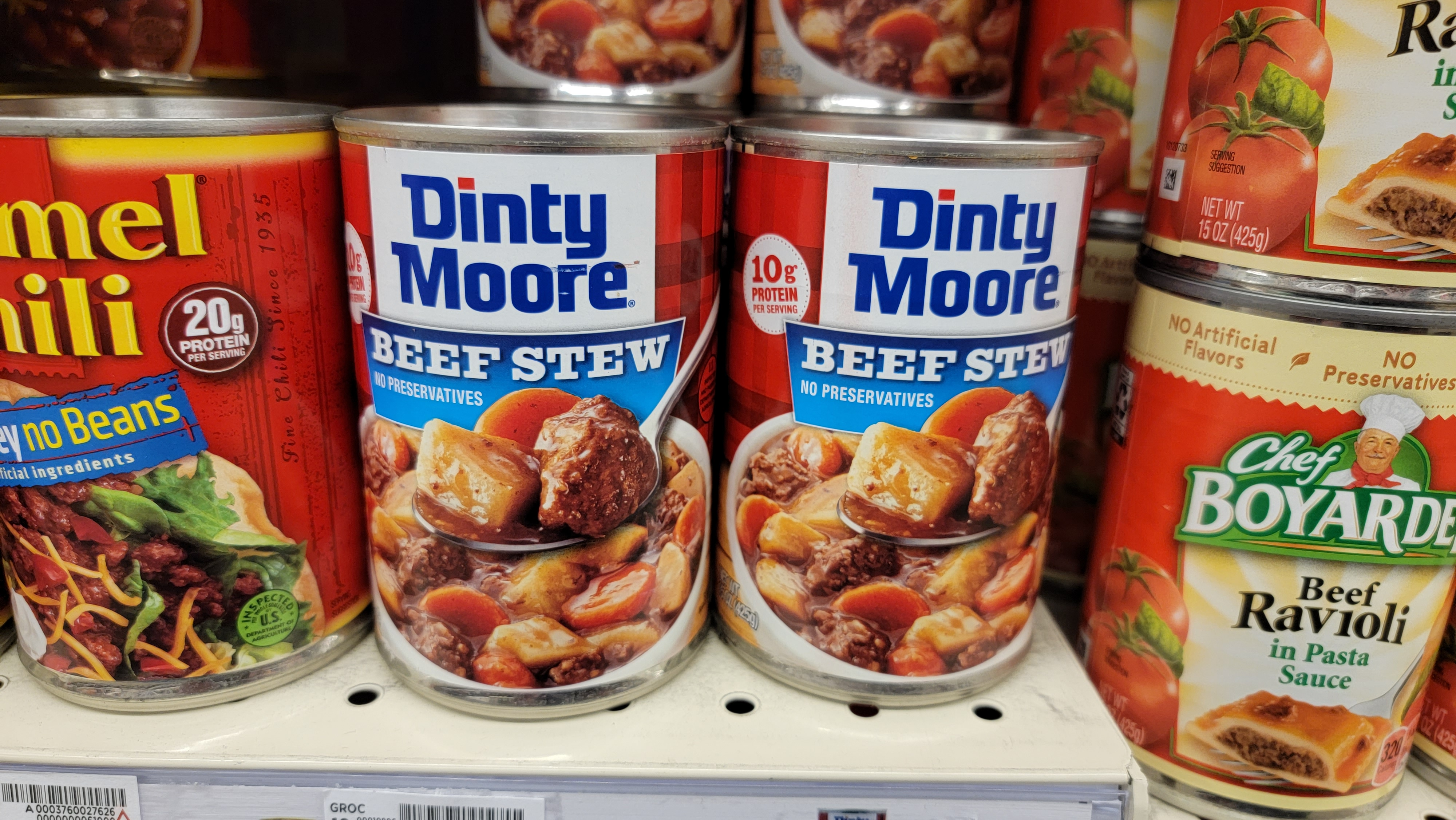The Comic Origins Of Dinty Moore Beef Stew
This canned stew is so much Moore than comfort food.
We may receive a commission on purchases made from links.
Whether it's the bacony goodness of bourguignon or a thick broth with mushrooms and potatoes, I love a hearty beef stew. There's nothing quite like that slow-braised richness, filling your house and stomach with the coziest of aromas and flavors. But as with fast food Tex-Mex, my fondness for beef stew didn't start from a high place. Rather, it began, almost as soon as I could eat solid food, with Hormel's classic Dinty Moore Beef Stew.
Just look at it. The red tartan can, the massive chunks of carrot, beef, and potatoes depicted on the label, and the all-caps proclamation of its contents: "BEEF STEW. NO PRESERVATIVES." I'll bet you can taste it now, as unmistakable as Campbell's Chunky or Chef Boyardee. As a child, I'd accept no substitutes to Dinty Moore, though once or twice, my family attempted to swap in Hormel's similar Meatball Stew. You can't fool me—there are no peas in Dinty.
I eventually outgrew my pickiness, but the love for this particular canned good remained. It was a rare treat in college, as well as a favorite hangover cure. Now, well after graduation, I still have a passion for lifelong learning. So when I recently picked up a can at the store, I got to wondering: Who is Dinty Moore, anyway?
Who is the Dinty Moore of Dinty Moore Beef Stew?
The question might as well be, "Who were the original Dinty Moores?" Because damn, there are quite a few. Wikipedia lists a band leader, multiple professional hockey and football players, and even a well-known writer as bearers of the name in question.
Yet according to comic historians, the moniker was first popularized in a strip called Bringing Up Father, which began in 1913. The main characters were a pair of Irish immigrant New Yorkers who frequented a tavern owned by a man called Dinty Moore.
But the name isn't purely an invention of fiction. The strip's creator, George McManus, was a friend and patron of a certain James Moore, who ran a restaurant in midtown Manhattan. In an effort to capitalize on the character he allegedly inspired, McManus rebranded his establishment as "Dinty Moore," opening multiple franchises under the banner.
So how did Dinty make the jump from Irish pub food to ready-to-eat stew? Well, Hormel licensed the naming rights in 1935 as part of its new lineup of canned goods. Stew wasn't the only foodstuff to appear under the banner: According to this photo posted on Hormel's Twitter account, corned beef hash and spaghetti with meatballs were also sold under the Dinty Moore label.
It turns out that another one of my favorite hangover cures also borrows the name Dinty Moore—the classic Rueben. According to Wikipedia (and multiple relevant sources), Michigan residents are known to chow down on a triple-decker Dinty Moore sandwich. Grobbel's Gourmet even lists a recipe, which calls for rye, corned beef, Swiss cheese, and Russian dressing.
What makes it different than your run-of-the-mill Reuben? Instead of piling on the sauerkraut, most Dinty Moore sandwiches swap in either coleslaw or shredded lettuce and tomato. There are other variables, such as the type and number of bread slices, but the idea of the sandwich holds true to that of the stew: You take a bunch of tasty things and throw them together, and the result is something better than the sum of its parts.
Dinty Moore’s advertising honors its comic strip origins
Despite the pallets' worth of cans I consumed, I don't recall much of Dinty Moore's ad campaigns from my childhood. But as an adult with an internet connection, I was curious: What did the classic commercials look like?
"Comical" is the answer. Hormel created a lumberjack mascot for its new product line, as shown in this 1973 spot that finally explains the thumbprint I remember from the old cans. As we transition into the '80s, the focus remains very kid-centric. If you want to call your sanity into question, there's this surrealist piece, which makes me deeply uncomfortable.
More recently, Hormel went back to its lumberjack vibes. These ads offer a nice balance of cartoony action and song, while allowing grown men (who probably grew up eating Dinty Moore) to goof off in front of and behind the camera. Even the "Crack a Stewski" catchphrase is something of a throwback, acknowledging the name's tavern origins.
Intentional or not, this adds a nice bit of subtlety to a product that's admittedly pretty basic. There's nothing fancy about the ingredients, preparation, or sale of Dinty Moore, and there are plenty of store-brand or imitation stews on the market. But my love of stew, both cooking and consuming it, began with the simple red can.

